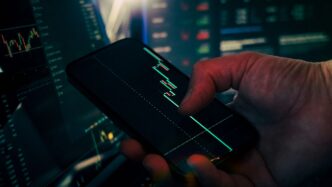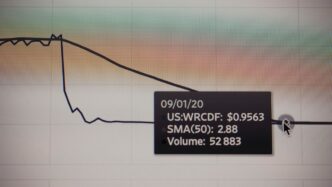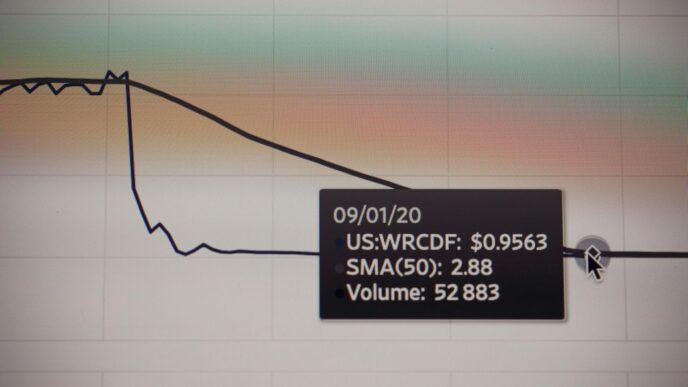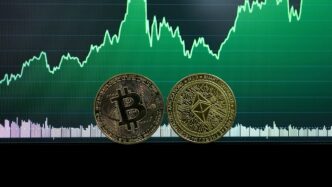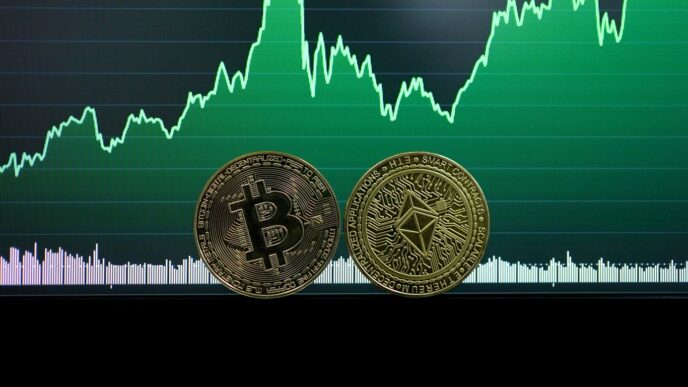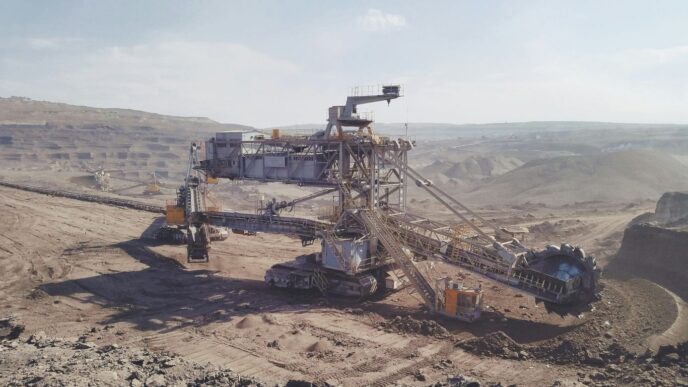Want to get a handle on what’s really happening in the crypto world? It’s not just about watching prices go up and down. A big piece of the puzzle is looking at exchange volume. This simply means how much crypto is being traded. By checking out these numbers, you can get a better idea of market trends, how people are feeling, and what might happen next. It’s like getting a peek behind the curtain of the crypto market, all thanks to understanding exchange volume.
Key Takeaways
- Understanding how much crypto is traded on both big, central platforms and smaller, decentralized ones helps you see the whole market picture.
- Things like new rules or cool new tech can really change how much crypto gets traded.
- Big world events, how confident investors are, and even what’s happening politically can all affect trading activity.
- Different parts of the world have their own trading habits, and knowing these can show you where the action is.
- Watching exchange volume can help you figure out if prices are about to change, or if someone is trying to mess with the market.
Analyzing Cryptocurrency Exchange Volume
Alright, let’s get into the nitty-gritty of crypto exchange volume. It’s not just about big numbers; it’s about understanding what those numbers mean. We’re talking about the lifeblood of the market, the fuel that drives price discovery and reveals hidden trends. Think of it like this: if the market is a car, exchange volume is the gasoline. Without it, you’re not going anywhere.
Understanding Centralized Exchange Volume
Centralized exchanges (CEXs) are still the big players, even with the rise of DeFi. They’re like the New York Stock Exchange of the crypto world – regulated (sort of), familiar, and generally easier for newcomers to use. Analyzing CEX volume means looking at order books, trade sizes, and the overall flow of assets in and out of the exchange. It’s important to remember that CEX volume can be influenced by things like wash trading (fake volume) and the presence of market makers. Here’s a quick rundown of what to keep an eye on:
- Total Volume: The raw amount of crypto traded in a 24-hour period. Higher volume usually means more liquidity and potentially more price stability. You can use this to understand crypto trading volume.
- Order Book Depth: How many buy and sell orders are stacked up at different price levels. A deep order book suggests strong support and resistance levels.
- Trade Size Distribution: Are most trades small retail orders, or are there a few whales making big moves? This can give you clues about market sentiment.
Understanding Decentralized Exchange Volume
Decentralized exchanges (DEXs) are the wild west of crypto. They’re all about freedom, self-custody, and cutting out the middleman. But that also means they can be a bit more complicated to use. DEX volume is a different beast than CEX volume. Instead of order books, DEXs use automated market makers (AMMs), which rely on liquidity pools. Analyzing DEX volume involves looking at things like:
- Liquidity Pool Sizes: How much crypto is locked up in each pool? Bigger pools usually mean less slippage (the difference between the expected price and the actual price you pay when trading).
- Swap Sizes: How big are the trades happening on the DEX? Large swaps can have a significant impact on price, especially for smaller pools.
- Number of Active Traders: How many unique addresses are interacting with the DEX? This gives you a sense of how popular the platform is.
Key Metrics for Exchange Volume Analysis
Okay, so you know what to look at, but how do you actually analyze it? Here are some key metrics that can help you make sense of the noise:
- Volume Ratio: Comparing the volume of a specific crypto to its average volume over a certain period. A spike in volume could signal a breakout or breakdown.
- Price-Volume Correlation: Is price moving in the same direction as volume? If price is going up but volume is flat, it could be a sign of a weak trend. If you want to learn more, research market analysis.
- On-Balance Volume (OBV): A cumulative indicator that adds volume on up days and subtracts it on down days. OBV can help you confirm trends and spot divergences.
Here’s a simple table to illustrate how these metrics might look in practice:
| Metric | Value | Interpretation |
|---|---|---|
| Volume Ratio | 1.5x | Volume is 50% higher than average, suggesting increased interest. |
| Price-Volume Corr | Positive | Price and volume are moving in the same direction, confirming the current trend. |
| OBV | Rising | Buying pressure is stronger than selling pressure. |
Remember, exchange volume analysis is just one piece of the puzzle. It’s important to combine it with other forms of analysis, like technical analysis and fundamental analysis, to get a complete picture of the market. And always, always do your own research before making any investment decisions.
Market Trends in Exchange Volume
Shifting Dynamics Between CEX and DEX Volume
Okay, so the whole CEX (centralized exchange) versus DEX (decentralized exchange) thing is getting interesting. It used to be that CEXs were the undisputed kings, but DEXs are slowly but surely gaining ground. DEXs offer more freedom and flexibility, which is attracting a lot of users. Think of it like this: CEXs are like traditional banks – they hold your crypto and handle the trades. DEXs are more like a peer-to-peer marketplace where you trade directly with others. While DEXs only accounted for about 3% of total trade volume in late 2023, their trading volume still hit a whopping $29 billion that November. That’s a big jump from previous lows. It’s a sign that people are liking the idea of decentralized finance more and more.
Impact of Regulatory Environments on Exchange Volume
Regulations, regulations, regulations. They’re always changing, and they have a HUGE impact on exchange volume. When governments crack down on crypto, volume tends to dip. When they’re more accepting, volume goes up. It’s pretty simple. For example, if the SEC in the US starts going after certain exchanges, people might move their funds to exchanges in countries with friendlier regulations. Or they might just decide to sit on the sidelines altogether. The lack of uniform standards is a limitation to the expansion. Traditional financial institutions are also starting to show interest in crypto, which is a sign that the industry is maturing. It’s a mix of the old and the new, and it’s definitely shaping how things are going. The growing popularity of cryptocurrencies as a medium of exchange has led central banks worldwide to support digital currencies.
Technological Innovations Driving Exchange Volume
Tech is always changing, and it’s a big driver of exchange volume. New features, faster trading, better security – all of these things can attract more users and lead to more trading. AI is also starting to play a bigger role, with some platforms using it to automate trading and provide better insights. And let’s not forget about NFTs and ETFs. The introduction of innovative products like NFTs and ETFs is expected to boost industry growth. The rise of mobile-based trading platforms is also making it easier for people to trade on the go, which is contributing to increased volume. It’s all about making crypto more accessible and user-friendly. The integration of artificial intelligence (AI) into trading platforms is poised to revolutionize online trading.
Factors Influencing Exchange Volume
Global Economic Conditions and Exchange Volume
Economic stability, or lack thereof, plays a big role in crypto exchange volume. When the traditional markets are shaky, people often look to crypto as an alternative, and that can really pump up the volume. Think of it like this: if the stock market is tanking, some investors might pull their money out and put it into Bitcoin or Ethereum, hoping for a better return. Conversely, a strong economy can sometimes lead to decreased crypto trading volume as people stick with more traditional investments. It’s all about where people think they can get the best bang for their buck. The crypto exchange platform market is affected by global economic conditions.
Investor Sentiment and Trading Activity
Investor sentiment is a huge driver. If there’s a lot of positive news and hype around a particular cryptocurrency, you’ll see more people buying and selling, which increases volume. Fear of missing out (FOMO) is a real thing in the crypto world! On the flip side, negative news or market crashes can cause panic selling, leading to a spike in volume as everyone tries to get out at once. It’s a rollercoaster of emotions, and those emotions directly impact trading activity. Here’s a quick breakdown:
- Positive Sentiment: Increased buying, higher volume.
- Negative Sentiment: Increased selling, higher volume.
- Neutral Sentiment: Relatively stable volume.
Geopolitical Events and Their Effect on Exchange Volume
Geopolitical events can have a pretty significant impact on crypto exchange volume. Major events like political instability, regulatory changes, or even international conflicts can create uncertainty in the market. For example, if a country suddenly bans cryptocurrency trading, you might see a huge spike in volume as people rush to sell off their holdings before the ban takes effect. Or, if a country adopts crypto in a big way, you might see increased volume as people try to get in on the action. It’s all about how these events affect people’s confidence in the market. The trading volume is influenced by market news and events.
Regional Variations in Exchange Volume
North American Exchange Volume Dominance
North America has been a major player in the crypto exchange market, often leading in overall volume. This is partly due to a more developed financial infrastructure and greater institutional participation. A lot of the big crypto companies are based there, and there’s generally more awareness and acceptance of digital assets. It’s not just the US either; Canada is also making strides in the crypto space. However, crypto exchange spot trading volume decreased in April 2025.
Asian Market Influence on Global Exchange Volume
Asia’s influence on global exchange volume is undeniable. Countries like China, South Korea, and Japan have historically been hotspots for crypto trading, despite regulatory changes. Even with restrictions, the sheer number of active traders in Asia means that the region significantly impacts global trends. The market is huge, and the interest is intense. It’s a region to watch closely, as shifts in Asian markets can send ripples throughout the entire crypto world.
Emerging Markets and Their Contribution to Exchange Volume
Emerging markets are increasingly contributing to global exchange volume. In places like Latin America and Africa, where traditional financial systems might be less accessible, crypto offers an alternative. Here are some reasons why:
- Financial Inclusion: Crypto provides access to financial services for the unbanked.
- Remittance: Digital assets offer a cheaper and faster way to send money across borders.
- Inflation Hedge: In countries with high inflation, crypto can be seen as a store of value.
These factors are driving increased adoption and, consequently, higher exchange volume in these regions. The cryptocurrency exchange platform market is projected to experience significant growth.
The Role of Exchange Volume in Price Discovery

Volume-Price Relationship in Crypto Markets
Okay, so let’s talk about how volume and price are related. It’s not rocket science, but it’s important. Basically, high volume usually confirms a price trend. If a price is going up and volume is also high, it means a lot of people are buying, and the trend is likely to continue. If the price is going up, but volume is low, it might just be a temporary thing. Think of it like this: a crowded concert is way more exciting than one with just a few people, right? Same idea.
Identifying Accumulation and Distribution Through Exchange Volume
Accumulation and distribution are fancy words for buying and selling by big players. Accumulation is when big investors are quietly buying up a bunch of a cryptocurrency. You can spot this by seeing a gradual increase in volume over time, even if the price isn’t jumping up super fast. Distribution is the opposite – big investors are selling off their holdings. This often shows up as high volume during a price decline. It’s like watching a store clear out its inventory; something’s up, and it’s probably not good for the price. Spotting crypto trading volume can be a key indicator.
Predicting Market Reversals with Exchange Volume
Can volume help you predict when the market is about to change direction? Sometimes, yeah. One thing to look for is something called "climactic volume." This is when you see a huge spike in volume, usually at the end of a trend. For example, if a price has been going up for a while, and then you see a massive volume spike with the price suddenly dropping, it could mean the trend is about to reverse. It’s like the market is running out of steam. But be careful, it’s not always a sure thing. You also need to look at other indicators to confirm your suspicions. Think of it as one piece of the puzzle, not the whole picture. The NKVO Exchange volume is a good example of this.
Strategic Applications of Exchange Volume Data
Okay, so you’ve been tracking exchange volume, looking at the charts, and maybe even feeling like you’re starting to understand what’s going on. But what can you actually do with all this data? It’s not just about knowing when volume is high or low; it’s about using that information to make smarter decisions. Let’s get into some practical ways to use exchange volume data.
Developing Trading Strategies Based on Exchange Volume
Exchange volume can be a key indicator for confirming trends or spotting potential breakouts. I mean, think about it: a price increase with low volume might just be a fluke, but a price increase with a huge spike in volume? That’s something to pay attention to. Here’s a few ideas:
- Volume Confirmation: Use volume to confirm the strength of a trend. If the price is going up and volume is also increasing, it suggests the uptrend is strong. If the price is going up but volume is decreasing, it might be a sign that the trend is weakening and could reverse. You can use a crypto trading platform to help with this.
- Breakout Strategy: Look for situations where the price breaks through a resistance level on high volume. This can signal the start of a new uptrend. Conversely, a breakdown below a support level on high volume can signal a downtrend.
- Volume-Weighted Average Price (VWAP): VWAP is a popular indicator that uses volume to calculate the average price of an asset over a period. Traders use VWAP to identify potential entry and exit points.
Risk Management Using Exchange Volume Indicators
Volume isn’t just for finding opportunities; it can also help you manage risk. Here’s how:
- Stop-Loss Orders: Use volume to set more effective stop-loss orders. For example, if you see a sudden spike in volume accompanied by a price drop, it might be a good time to tighten your stop-loss to protect your profits or limit your losses.
- Position Sizing: Adjust your position size based on volume. If the volume is low, it might be wise to reduce your position size to avoid getting caught in a low-liquidity trap. Higher volume generally means more liquidity, allowing for larger positions.
- Volatility Assessment: High volume often indicates increased volatility. Be prepared for larger price swings and adjust your trading strategy accordingly. Consider using options or other hedging strategies to protect your portfolio.
Identifying Market Manipulation Through Anomalous Exchange Volume
Okay, this is where things get interesting. Unusual volume patterns can sometimes be a sign of market manipulation. It’s not always easy to spot, but here are some things to look for:
- Sudden Volume Spikes: Be wary of sudden, unexplained spikes in volume, especially if they are followed by rapid price movements. This could be a sign of a pump-and-dump scheme or other manipulative tactics. Keep an eye on market trends.
- Wash Trading: Wash trading involves buying and selling the same asset to create artificial volume. This can be difficult to detect, but look for patterns of high volume with little or no price movement.
- Order Book Imbalances: Pay attention to the order book. Large buy or sell orders that suddenly appear and disappear can be a sign of manipulation. These
Future Outlook for Crypto Exchange Volume

Projected Growth in Global Exchange Volume
The future of crypto exchange volume looks pretty interesting, to be honest. The global cryptocurrency market is expected to keep growing, with some estimates projecting it to reach almost $2 billion by 2028. That’s a pretty big jump from where we are now. A lot of this growth will probably come from more people getting into crypto, especially in countries where the economy isn’t doing so great. People are looking for alternatives to traditional money, and crypto could be it. Plus, with new stuff like NFTs and ETFs becoming more popular, there’s even more reason for people to trade crypto. The crypto market cap is already pretty high, and it’s only going to get bigger.
Impact of Institutional Adoption on Exchange Volume
Big companies and investment firms are starting to take crypto seriously, and that’s a game-changer. When these institutions start trading crypto, it brings a lot more money into the market, which can really boost exchange volumes. But it’s not just about the money. These institutions also bring more legitimacy to the crypto world, which can make more regular people feel comfortable investing. It’s like when your grandma finally figures out how to use the internet – it makes everyone else feel like it’s okay to use too. The interest of traditional financial institutions is likely to continue shaping the market.
The Evolution of Trading Platforms and Exchange Volume
Trading platforms are constantly changing, and that’s affecting exchange volume too. We’re seeing more AI being used in trading, which can make things faster and more efficient. Plus, there’s a big push for decentralized finance (DeFi), which is changing how people trade crypto. DeFi platforms let people trade directly with each other, without needing a middleman like a traditional exchange. This could lead to some interesting shifts in where trading volume is happening. The cryptocurrency exchange platform market is expected to grow at a rapid pace, so we’ll see a lot of innovation in this area.
Here’s a quick look at how the market is expected to grow:
| Year | Projected Market Size (USD Billion) |
|---|---|
| 2022 | 37.07 |
| 2030 | 264.32 |
Conclusion
So, we’ve looked at how crypto exchange volumes can tell us a lot about what’s happening in the market. It’s pretty clear that keeping an eye on these numbers helps you get a better feel for things. The crypto world is always changing, right? One day it’s up, the next it’s down. But by paying attention to how much crypto is being traded, and where, you can start to see patterns. It’s not about predicting the future perfectly, because nobody can do that. It’s more about understanding the flow, seeing what’s popular, and maybe spotting a shift before everyone else does. This kind of insight can be really helpful, whether you’re just curious or you’re actually involved in trading. It just gives you a clearer picture of this wild and exciting financial space.
Frequently Asked Questions
What is ‘exchange volume’ in simple terms?
Exchange volume is simply the total amount of cryptocurrency traded on an exchange over a certain time. It’s like checking how many items were sold in a store. High volume often means lots of people are buying and selling, showing a lot of interest in that crypto.
What’s the difference between Centralized and Decentralized Exchanges?
Centralized exchanges (CEX) are like traditional banks where a company holds your crypto and manages trades. Decentralized exchanges (DEX) are more like a peer-to-peer marketplace where you control your own crypto directly. CEXs are usually easier to use, while DEXs offer more privacy and control.
How does exchange volume help us understand crypto prices?
Looking at exchange volume helps us see how popular a cryptocurrency is. If volume goes up with price, it means many people agree with the price change. If volume is low, a price change might not be as strong or reliable.
What kind of things make exchange volume change a lot?
Big news events, like new rules from governments or major companies getting involved in crypto, can make trading volume jump. Even everyday things like how people feel about the economy can affect how much crypto is bought and sold.
Does crypto trading volume differ around the world?
Yes, different parts of the world have different amounts of crypto trading. For example, North America and Asia often have very high trading volumes because many people there are interested in crypto. Emerging markets are also growing fast.
Can exchange volume help me make better trading decisions?
By watching exchange volume, traders can try to guess where prices might go next. For instance, a sudden drop in volume after a big price increase might mean the price is about to fall. It’s a tool to help make smarter trading decisions.



